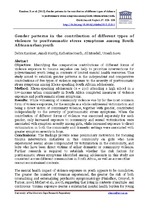| dc.contributor.author | Kaminer, Debra | |
| dc.contributor.author | Hardy, Anneli | |
| dc.contributor.author | Heath, Katherine | |
| dc.contributor.author | Mosdell, Jill | |
| dc.contributor.author | Bawa, Umesh | |
| dc.date.accessioned | 2017-07-13T13:46:48Z | |
| dc.date.available | 2017-07-13T13:46:48Z | |
| dc.date.issued | 2013 | |
| dc.identifier.citation | Kaminer, D. et al. (2013). Gender patterns in the contribution of different types of violence to posttraumatic stress symptoms among South African urban youth. Child Abuse & Neglect, 37: 320 - 330 | en_US |
| dc.identifier.issn | 0145-2134 | |
| dc.identifier.uri | http://hdl.handle.net/10566/3071 | |
| dc.identifier.uri | http://dx.doi.org/10.1016/j.chiabu.2012.12.011 | |
| dc.description.abstract | OBJECTIVE: Identifying the comparative contributions of different forms of violence exposure
to trauma sequelae can help to prioritize interventions for polyvictimized youth living
in contexts of limited mental health resources. This study aimed to establish gender patterns
in the independent and comparative contributions of five types of violence exposure
to the severity of posttraumatic stress symptoms among Xhosa-speaking South African
adolescents.
METHOD: Xhosa-speaking adolescents (n = 230) attending a high school in a low-income
urban community in South Africa completed measures of violence exposure and posttraumatic
stress symptoms.
RESULTS: While witnessing of community violence was by far the most common form of violence
exposure, for the sample as a whole only sexual victimization and being a direct victim
of community violence, together with gender, contributed independently to the severity of
posttraumatic stress symptoms. When the contribution of different forms of violence was
examined separately for each gender, only increased exposure to community and sexual
victimization were associated with symptom severity among girls, while increased exposure
to direct victimization in both the community and domestic settings were associated
with greater symptom severity in boys.
CONCLUSIONS: The findings provide some preliminary motivation for focusing trauma
intervention initiatives in this community on girls who have experienced sexual abuse
compounded by victimization in the community, and boys who have been direct victims of
either domestic or community violence. Further research is required to establish whether
the risk factors for posttraumatic stress symptoms identified among adolescents in this
study are consistent across different communities in South Africa, as well as across other
resource-constrained contexts. | en_US |
| dc.language.iso | en | en_US |
| dc.publisher | Elsevier | en_US |
| dc.rights | This is the author-version of the article published online at: http://dx.doi.org/10.1016/j.chiabu.2012.12.011 | |
| dc.subject | Posttraumatic stress | en_US |
| dc.subject | Violence | en_US |
| dc.subject | Victimization | en_US |
| dc.subject | South Africa | en_US |
| dc.subject | Adolescents | en_US |
| dc.title | Gender patterns in the contribution of different types of violence to posttraumatic stress symptoms among South African urban youth | en_US |
| dc.type | Article | en_US |
| dc.privacy.showsubmitter | FALSE | |
| dc.status.ispeerreviewed | TRUE | |
| dc.description.accreditation | ISI | |

